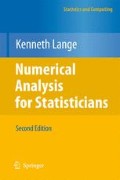Abstract
The Fourier transform is one of the most productive tools of the mathematical sciences. It crops up again and again in unexpected applications to fields as diverse as differential equations, numerical analysis, probability theory, number theory, quantum mechanics, optics, medical imaging, and signal processing [3, 5, 7, 8, 9]. One explanation for its wide utility is that it turns complex mathematical operations like differentiation and convolution into simple operations like multiplication. Readers most likely are familiar with the paradigm of transforming a mathematical equation, solving it in transform space, and then inverting the solution. Besides its operational advantages, the Fourier transform often has the illuminating physical interpretation of decomposing a temporal process into component processes with different frequencies.
Access this chapter
Tax calculation will be finalised at checkout
Purchases are for personal use only
Preview
Unable to display preview. Download preview PDF.
References
Barndorff-Nielsen OE, Cox DR (1989) Asymptotic Techniques for Use in Statistics. Chapman and Hall, London
Daniels HE (1982) The saddlepoint approximation for a general birth process. J Appl Prob 19:20-28
Dym H, McKean HP (1972) Fourier Series and Integrals. Academic Press, New York
Feller W (1971) An Introduction to Probability Theory and Its Applications, Volume 2, 2nd ed. Wiley, New York
Folland GB (1992) Fourier Analysis and its Applications. Wadsworth and Brooks/Cole, Pacific Grove, CA
Hall P (1992) The Bootstrap and Edgeworth Expansion. Springer, New York
Körner TW (1988) Fourier Analysis. Cambridge University Press, Cambridge
Lighthill MJ (1958) An Introduction to Fourier Analysis and Generalized Functions. Cambridge University Press, Cambridge
Rudin W (1973) Functional Analysis. McGraw-Hill, New York
Author information
Authors and Affiliations
Corresponding author
Rights and permissions
Copyright information
© 2010 Springer New York
About this chapter
Cite this chapter
Lange, K. (2010). The Fourier Transform. In: Numerical Analysis for Statisticians. Statistics and Computing. Springer, New York, NY. https://doi.org/10.1007/978-1-4419-5945-4_19
Download citation
DOI: https://doi.org/10.1007/978-1-4419-5945-4_19
Published:
Publisher Name: Springer, New York, NY
Print ISBN: 978-1-4419-5944-7
Online ISBN: 978-1-4419-5945-4
eBook Packages: Mathematics and StatisticsMathematics and Statistics (R0)

